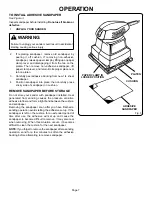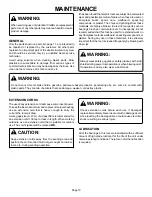
Page 8
OPERATION
APPLICATIONS
(Use only for the purposes listed below)
1. Sanding on wood surfaces.
2. Removing rust from and sanding steel surfaces.
WARNING:
Do not wear loose clothing or jewelry when operating
sander. They could get caught in moving parts causing
serious injury. Keep head away from sander and sanding
area. Hair could be drawn into sander causing serious
injury.
TO OPERATE
Clamp or otherwise secure the work to prevent it from
moving under your sander.
WARNING:
Unsecured work could be thrown towards the operator
causing injury.
Hold your sander in front and away from you, keeping it clear
of the workpiece. Start your sander by pressing the switch to
ON position and letting the motor build to its maximum
speed. Gradually lower your sander on the work with a slight
forward movement.
See Figure 4. Move it slowly using
forward and backward strokes.
DO NOT FORCE. The weight of the unit supplies adequate
pressure, so let the sanding sheet and sander do the work.
Applying additional pressure only slows the motor, rapidly
wears sandpaper and greatly reduces sander speed.
Excessive pressure will overload the motor causing possible
damage from motor overheating and can result in inferior
work. Any finish on resin or wood may soften from the
frictional heat. Do not allow sanding on one spot too long as
the sander's rapid action may remove too much material,
making the surface uneven. Always lift your sander from
workpiece before turning off.
Flush sanding can be performed with your sander. As shown
in figure 5, the front edge of your sander allows flush sanding
in corners. The two side edges can also be used when
sanding in corners. Always remove sander from workpiece
before turning your sander off.
ORBITAL MOTION
Orbital motion is ideal for fast cutting action when removing
old finishes, smoothing rough wood, cutting stock down to
required dimensions or for finishing surfaces to be painted.
As shown in Figure 6, the sandpaper moves in tiny circles at
a very high speed, allowing the sander to move easily.
Fig. 6
Fig. 4
ORBITAL MOTION
Fig. 5































